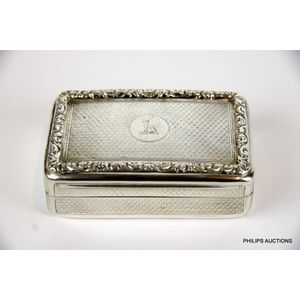George IV Silver Snuff Box with Fox Armorial
You must be a subscriber, and be logged in to view price and dealer details.
Subscribe Now to view actual auction price for this item
When you subscribe, you have the option of setting the currency in which to display prices to $Au, $US, $NZ or Stg.
- Engine Turned - Engine turning is a decorative technique used on metal surfaces to create intricate curving or geometric pattern. The process involves cutting a series of lines into the surface of the metal using a rose engine or decoration lathe which rotates the metal as it cuts, allowing the operator to create a repeating pattern that covers the entire surface. The resulting surface has a shimmering, reflective quality that is often described as "engine turned." Where an engine turned item has been enamelled, the term used to describe the decoration is usually guilloche.
Engine turning was originally developed to decorate metal objects such as firearms, scientific instruments, and other metal objects that required precise and elegant design. - Armorial / Armourial - Bearing a coat of arms. Coats of arms came into general use by feudal lords and knights in in the 12th century, and by the 13th century, arms had spread beyond their initial battlefield use to become a flag or emblem for families in the higher social classes of Europe. They were inherited from one generation to the next. When a family crest is used on individual items of silver or furniture it is an indicator of the aristocratic standing of the family represented.
Armorials were also used to decorate mass produced ceramic souvenir ware by such companies as Goss, Carlton & Shelley, and in these cases the coats of arms displayed were of boroughs and cities. - Cartouche - An ornamental panel in the form of of a shield, oval or rectangular scroll with curling edges. It may be carved into the back of a chair or the top of a sideboard, or present on a piece of silver or jewellery, and contain the initials of the original owner, heraldic symbols, or some other inscription, such as the details of a presentation.
In ceramics the term defines the central area of a vase or similar with a decorative border in one of the shapes above, into which a decorative scene or figures have been painted. - Sterling Silver - Sterling silver is a mixture of 92.5% pure silver and 7.5% of another metal, usually copper. Fine silver is 99.9% pure silver, and is relatively soft and the addition of the very small amount of copper gives the metal enough strength and hardness to be worked into jewellery, decorative and household objects.
- George Iv - George IV (1762 ? 1830) was king of the United Kingdom of Great Britain and Ireland and king of Hanover from 1820, until his own death in 1830. From 1811 until his accession in 1820, he served as Prince Regent during his father's final mental illness.
In English furniture design, his reign from 1811 to 1830 is known as the Regency period.
This item has been included into following indexes:
Visually similar items

A fine 14 carat gold engine turned lady's compact, early 20th century, German, with mark of Scherk, in rose and yellow gold with a fine trellis design to the body enclosed by formal scroll borders and edges, the interior with a mirror, retractable lipstick

19th century silver snuff box, with bright cut lid, tested as silver, 6 cm wide, 26 grams

A George III sterling silver snuff box, 1817 London, with maker's mark We, probably William Elliot, the delightfully crafted box fashioned as a satchel, with prick work and wriggle work decoration; hallmarked to the gilt interior. Silver weight 49gr. Lengt

A very small George III silver vinaigrette, oblong with fruiting vine embossed border and 'Rope-Work' walls; the gilded interior with foliate pierced grill. Birmingham 1818 by Lawrence & Co. Width 2.2 cm
